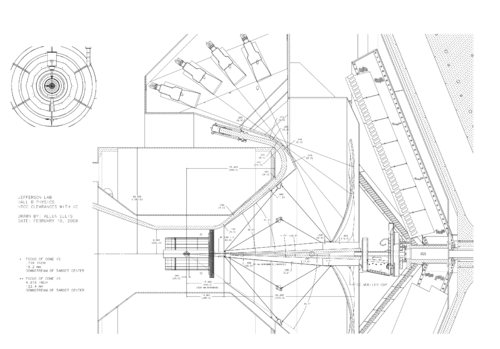Difference between revisions of "Lead Shield Cone"
Jump to navigation
Jump to search
| Line 49: | Line 49: | ||
The geometry looks like | The geometry looks like | ||
| − | [[File:HTCC_section_with_ic_v3.png]] | + | [[File:HTCC_section_with_ic_v3.png | 500 px]] |
Revision as of 17:12, 16 January 2018
We need to edit the EXn02DetectorConstruction file to allow for a target that is a lead cone to simulate the Moller Shield. The header file for an elliptical Cone gives the parameters need to call with.
// $Id: G4EllipticalCone.hh 67011 2013-01-29 16:17:41Z gcosmo $ // // // -------------------------------------------------------------------- // GEANT 4 class header file // // G4EllipticalCone // // Class description: // // G4EllipticalCone is a full cone with elliptical base which can be cut in Z. // // Member Data: // // xSemiAxis semi-axis, x, without dimentions // ySemiAxis semi-axis, y, without dimentions // zheight height, z // zTopCut upper cut plane level, z // // The height in Z corresponds to where the elliptical cone hits the // Z-axis if it had no Z cut. Also the cone is centered at zero having a // base at zTopCut and another at -zTopCut. The semi-major axes at the Z=0 // plane are given by xSemiAxis*zheight and ySemiAxis*zheight so that the // curved surface of our cone satisfies the equation: // // *************************************************************************** // * * // * (x/xSemiAxis)^2 + (y/ySemiAxis)^2 = (zheight - z)^2 * // * * // *************************************************************************** // // In case you want to construct G4EllipticalCone from : // 1. halflength in Z = zTopCut // 2. Dx and Dy = halflength of ellipse axis at z = -zTopCut // 3. dx and dy = halflength of ellipse axis at z = zTopCut // ! Attention : dx/dy=Dx/Dy // // You need to find xSemiAxis,ySemiAxis and zheight: // // xSemiAxis = (Dx-dx)/(2*zTopCut) // ySemiAxis = (Dy-dy)/(2*zTopCut) // zheight = (Dx+dx)/(2*xSemiAxis)
